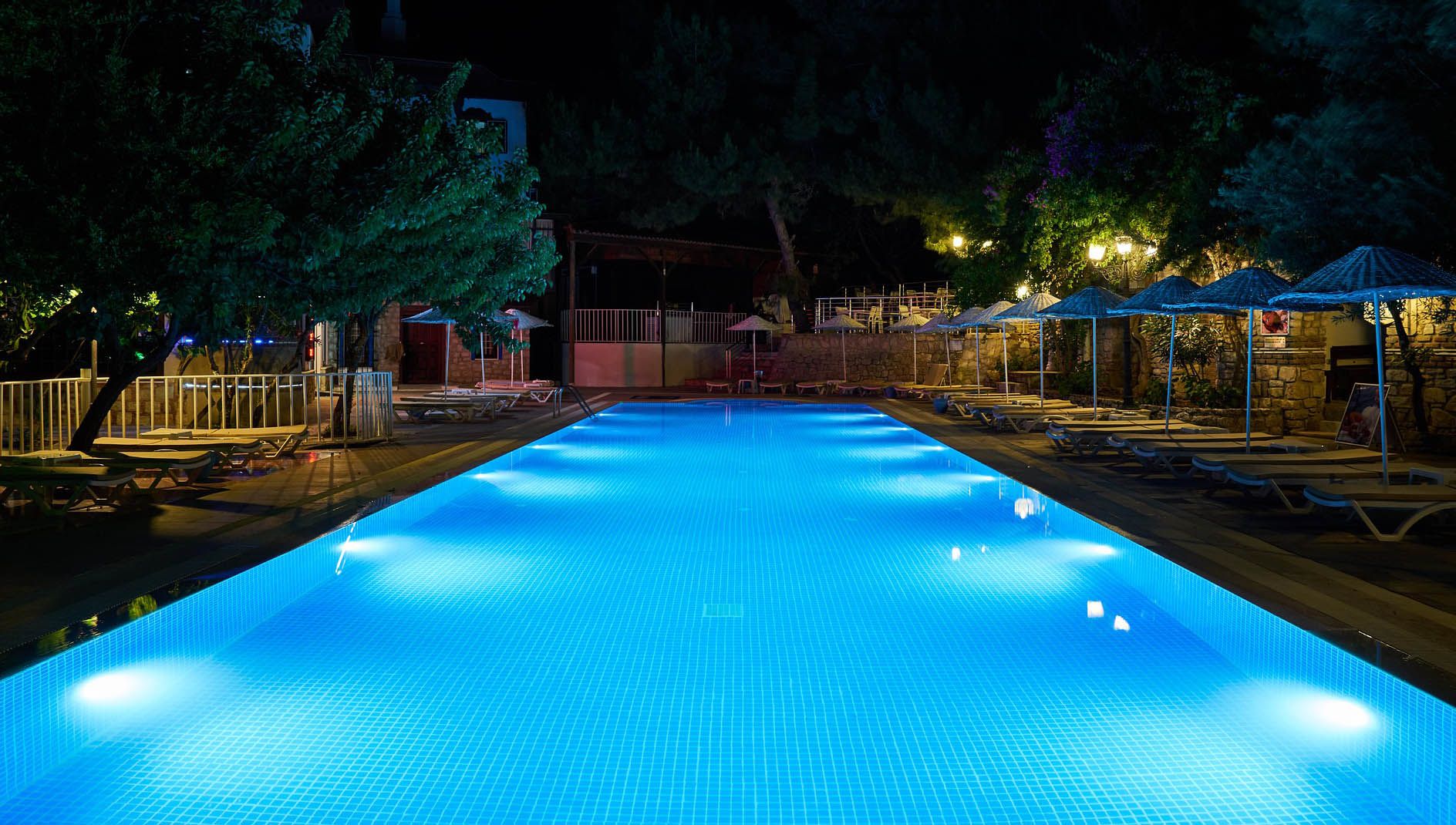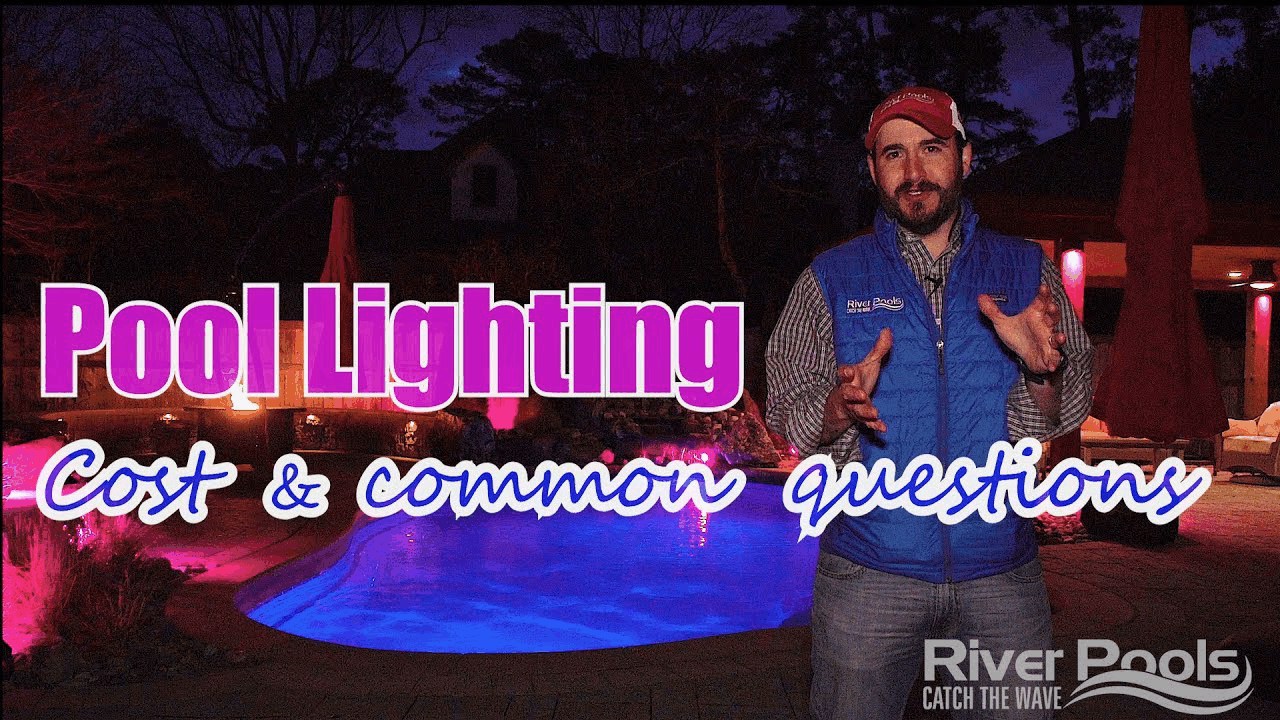Inground Pool Light Cost & Other Common Lighting Questions
April 21st, 2015
4 min read
By Jason Hughes

If you’re considering an inground pool, you are probably also considering installing underwater pool lights. As we specialize in fiberglass swimming pools, we have the opportunity to answer tons of questions about pool lighting. In this article, we’re going to tackle some of the most popular inground pool lighting questions we receive on a daily basis.

What should I know about pool lights?
Lighting your pool lets you swim at night with multicolored ambient light. LED pool lights allow you to change colors with a flip of a switch. In-pool lights must be installed during construction. Smaller LED lights cost $700–$900 installed, and fiber optics cost $1,300–$1,700. The only required maintenance is replacing the bulb.
Why should I light my pool?
First of all, lighting your pool will allow you to take full advantage of your pool both day and night. Many folks find night swimming a wonderful experience, but it’s simply not the same without ambiance of the reflective light that an underwater light provides.
Lighting your inground pool also allows peace of mind when watching little ones swim after dark as it adds better visibility throughout the entire pool.
Do pool lights have to be installed during construction, or can they be added later?
Some pool accessories can be added later, but pool lights don’t offer that flexibility…not without major renovation work anyway.
We would suggest if you’re remotely considering a pool light, it’s best to have it installed during construction.
How many lights do I need?
It depends on the type of light, but we currently use the smaller LED lights like the Globright or the Pal 2000 in our fiberglass pools and suggest that one light, at a minimum, will adequately illuminate a pool up to 30’ long. Pools longer than 30’ will require two lights. Please note that this is a bare minimum, most folks end up getting two lights in any pool, and some even have us install three on very large pools.
What are my lighting options and what are the pros and cons of each?
The predominant pool light on the market today is LED, but fiber optic lighting as well as incandescent lighting are also available. Let’s take a closer look at each.
LEDs
LED stands for Light Emitting Diodes, illuminated by the movement of electrons within a semiconductor material.
LEDs have no filaments, so they emit no heat.
LEDs also change colors and have several light show settings.
LED bulbs have a very long life span…about 30,000 hours compared to the 5,000 hours of the incandescent and the 6,000 hours fiber optics. That's the equivalent of SIX incandescent replacements and FIVE fiber optic replacements.
Fiber Optics
Fiber optic pool lights hit their peak in the early 2000s and have lost market share with the widespread use of LED technology.
The design of fiber optic pool light is unique in that the light bulb is actually located in a dry box on top of the pool patio. The light from this bulb travels through fiber optic cables a special fitting within the pool wall where the cable ends and the light shines out into the pool.
Some fiber optic lights have a color wheel located within the box which the light shines through, causing the light in the pool to change color.
The major disadvantage of fiber optic lights is they are simply the least bright of all the lighting options.
As we will see later, they are also very expensive, especially for the amount of light they emit.
Incandescents
Incandescents work by electrical current passing through a wire, known as filament, to heat up. The filament glows, producing the bright light associated with an incandescent bulb.
The first disadvantage of incandescent bulbs is that in order to change color, a colored lens must be placed over the pool light inside the pool. This was fine twenty years ago, but a bit antiquated today.
Second, the bulb life is much shorter than that of LED bulbs.
How much do inground pool lights cost?
At the time of this writing, full size LED pool lights, like what are typically installed in vinyl liner or concrete pools, usually cost between $1,000 and $1,500 installed.
The smaller LED lights like the Pentair Globrite or PAL 2000 typically cost between $700 and $900 installed.
Fiber optic pool lights are usually around $1,300 to $1,700 installed.
Full size incandescent pool lights are typically in the range of $450 to $650.
What maintenance is required?
The only required maintenance for any pool light is bulb replacement.
Regardless of the type of light, you should never have to lower the water level in the pool to replace the bulb. In some cases, you can loosen a single screw, elevate the bulb housing above water level and replace the bulb. This process only takes five to ten minutes.
Other lights, however, require that the entire housing be replaced, which takes a little longer but still not a major ordeal, especially considering the average bulb lasts many, many years.
Fiber optic bulb replacement is very simple as you simply remove the box cover, located on or near the patio, and snap in a new bulb.
Bulb replacement costs at the time of this writing are as follows:
- Large LED $450–$650
- Small LED $50–$350 depending on the model
- Fiber optic $20–$60
- Incandescent $30–$70
Are pool lights safe?
In short, yes they are extremely safe, so long as they are installed according to manufacturer’s specifications and compliant with local building codes.
Modern pool lights, installed correctly, are virtually risk free.
Well, we hope you have found this informative, and wish you the best of luck in your efforts to find the right pool light for you. Take a look at our pool lighting article and other pool options.
As always, feel free to leave any comments or questions below.
Up Next:
7 Pool Extras That Won't Break the Budget
What’s the Best Small Fiberglass Pool for Your Needs? Costs, Sizes, Features
Editor's note: This blog article was updated on February 18, 2020.
Editor's Note: This article was originally written by Jason Hughes on April 15, 2015. Any opinions expressed are those of the author. Any prices referenced were based on information that was readily available at the time.
River Pools is a brand of inground fiberglass pools produced in a manufacturing facility in Fortville, IN. While our expertise is in manufacturing fiberglass pools, we have access to a network of installers with expertise relating to project design, installation, and pool service. We often tap into this knowledge base and share information freely with homeowners, just like you, considering installing a swimming pool in your backyard.
Jason Hughes is a partner at River Pools Virginia, a fiberglass pool installation company based in Warsaw, Virginia. With over 20 years of hands-on experience, Jason has dedicated his career to helping families create beautiful, functional backyards while ensuring every fiberglass pool installation meets the highest standards of quality and safety. In addition to his work with homeowners, Jason serves as a GENESIS instructor with the Pool & Hot Tub Alliance (PHTA), where he teaches fiberglass pool installation best practices to pool professionals across the country. Whether he’s on a job site or leading a training session, Jason is passionate about raising the bar for fiberglass pool installations and helping families make confident, informed decisions as they transform their outdoor spaces.
Topics:

